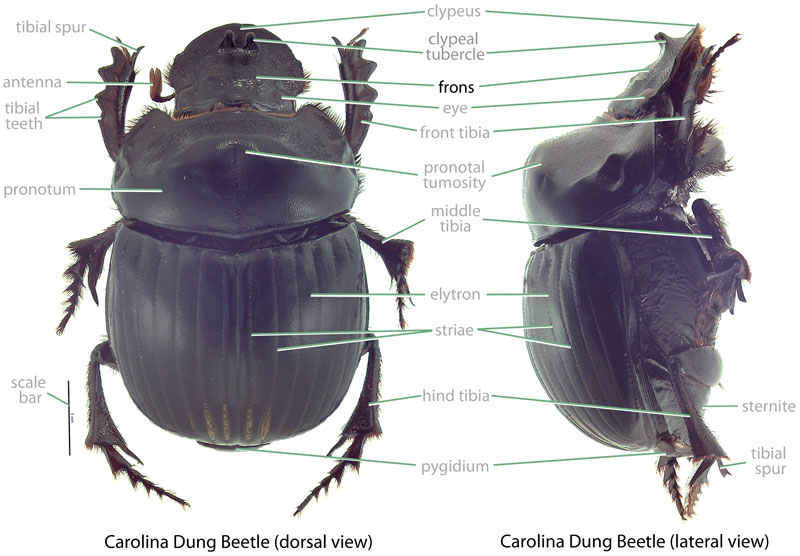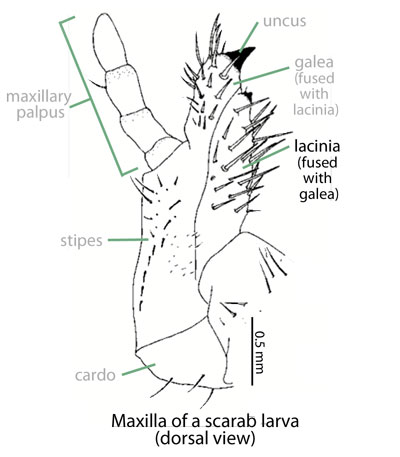USDA Regulated Pest
none known
Family: Scarabaeidae Subfamily: Melolonthinae Genus: Holotrichia Species: Holotrichia bipunctata Brenske, 1892
none available
Total body length 13.8–18.1 mm (0.54–0.71 in). Body shape cylindrical, somewhat elongate. Color yellowish-brown. sinuatesinuate:
gently curved (specifically of margins or edges); often in reference to the clypeus
.0-segmented; club 3-segmented; male club slightly shorter than segments 2-7; female club half the length of segments 2-7. Clypeusclypeus:
part of the head anterior to the frons; the most anterior portion in dorsal view
 reflexed; sinuatesinuate:
reflexed; sinuatesinuate:
gently curved (specifically of margins or edges); often in reference to the clypeus
. Head with weak ridge at base of fronsfrons:
part of the head generally positioned between the eyes (posterior to the clypeus and anterior to the vertex) and visible dorsally
 . Pronotumpronotum:
. Pronotumpronotum:
the dorsal surface of the thorax
 with obvious constriction posteriorposterior:
with obvious constriction posteriorposterior:
towards the rear end; opposite of anterior
to apical angle; female with distinct foveafovea:
a depressed pit or indentation
at each side of anterioranterior:
the front or forward; opposite of posterior
margin; male lacking foveafovea:
a depressed pit or indentation
. ElytraElytra:
the hardened and chitinous wing-cover of a beetle that protect and overlie the flight wing
smooth; lacking prominent setaesetae:
small, hair-like structure
.
(Boving, 1945Boving, 1945:
Boving A. 1945. Description of the larva and pupa of the scarab beetle Ancylonycha mindanaona (Brenske). Journal of the Washington Academy of Science 35: 13-15. full text (accessed 2015)): Grub C-shaped, not hump-backed, cylindrical, whitish, numerous dark spots on body. Maxillamaxilla:
set of paired mouthparts located posterior to the mandibles
with galeagalea:
outer branch or lobe of the maxilla
 and lacinialacinia:
and lacinialacinia:
inner portion of the maxilla fused. Mandiblemandible:
fused. Mandiblemandible:
The crushing or chewing portion of an insects mouthparts
 with basolateralbasolateral:
with basolateralbasolateral:
relating to base of the side part/portion
region with 7 setae; dorsoexteriordorsoexterior:
relating to the upper and outer part/portion
region lacking setaesetae:
small, hair-like structure
and punctures. Epipharynxepipharynx:
lobe on the interior surface of the labrum or clypeus
haptomerum with 9 heliheli:
in scarab larvae, a coarse spine on or near the haptomerum
. ProplegmatiumProplegmatium:
in scarab larvae, an area of folded, parallel ridges before the plegmatium
 absent. Last antennal segment with single large, oblong, dorsaldorsal:
absent. Last antennal segment with single large, oblong, dorsaldorsal:
of or relating to the upper surface; opposite of ventral
sensory spot. Respiratory plates of spiraclesspiracles:
opening on the abdomen or thorax through which air enters and exits the body
 cribriformcribriform:
cribriformcribriform:
sieve-like in appearance
, not constricted. Rasterraster:
in scarab larvae, a complex of setose, spiny, and bare areas on the ventral surface of the last abdominal segment with closely set palidiapalidia:
with closely set palidiapalidia:
paired group(s) of recumbent (reclining) spines, usually occurring in rows; part of the raster
. PaliPali:
in scarab larvae, a straight, pointed spine, particularly as relates to the raster
short, pointed, slightly curved. Anal opening V-shaped.
Philippines. This species is native to the island of Mindanao, the southernmost of the major Philippine Islands (Cartwright and Gordon, 1971Cartwright and Gordon, 1971:
Cartwright O and Gordon R. 1971. Insects of Micronesia Coleoptera: Scarabaeidae. Insects of Micronesia 17: 256-296.). This beetle is also known from the Philippine island of Luzon (Oakley, 1945Oakley, 1945:
Oakley R. 1945. Preliminary life-history studies in Guam of the scarab beetle Ancylonycha mindanaona (Brenske). Journal of the Washington Academy of Science 35: 7-12. full text (accessed 2015)).
This species feeds on a variety of cultivated and wild plants. Amongst plants of economic interest, adults have been found on: avocado (Persea spp.), banana (Musa spp.), breadfruit (Artocarpus altilis), cassava (Manihot esculenta), coconut (Cocos nucifera), coffee (Coffea spp.), corn (Zea mays), and kapok (Ceiba pentandra) (Oakley, 1945Oakley, 1945:
Oakley R. 1945. Preliminary life-history studies in Guam of the scarab beetle Ancylonycha mindanaona (Brenske). Journal of the Washington Academy of Science 35: 7-12. full text (accessed 2015)). LarvaeLarvae:
the immature form of an insect; in scarabs, also called grub or white grub; preceded by the egg stage, followed by the pupal stage
 also attack plants, feeding on the roots of beans (Phaseolus spp.), citrus (Citrus spp.), coconut (Cocos nucifera), corn (Zea mays) (Oakley, 1945Oakley, 1945:
also attack plants, feeding on the roots of beans (Phaseolus spp.), citrus (Citrus spp.), coconut (Cocos nucifera), corn (Zea mays) (Oakley, 1945Oakley, 1945:
Oakley R. 1945. Preliminary life-history studies in Guam of the scarab beetle Ancylonycha mindanaona (Brenske). Journal of the Washington Academy of Science 35: 7-12. full text (accessed 2015)), and rice (Oryza sativa) (Litsinger et al., 2002Litsinger et al., 2002:
Litsinger J, Libetario E, Barrion A. 2002. Population dynamics of white grubs in the upland rice and maize environment of Northern Mindanao, Philippines. International Journal of Pest Management 48: 239-260. DOI: 10.1080/09670870210131861.).
(Oakley, 1945Oakley, 1945:
Oakley R. 1945. Preliminary life-history studies in Guam of the scarab beetle Ancylonycha mindanaona (Brenske). Journal of the Washington Academy of Science 35: 7-12. full text (accessed 2015)): Adults of this beetle are generalist herbivores, feeding at night on the foliage of a variety of plant species. At daybreak, adults fly to the ground and burrow into the soil, re-emerging at dusk. In Guam, there appears to be one generation per year with adult activity peaking in March and April. Females deposit eggs 10–15 cm (4–6 in) under loose soils. LarvaeLarvae:
the immature form of an insect; in scarabs, also called grub or white grub; preceded by the egg stage, followed by the pupal stage
 emerge from their eggs after 11–15 days. The larval stage lasts 290–309 days and is followed by a 14–15 day pupal stage.
emerge from their eggs after 11–15 days. The larval stage lasts 290–309 days and is followed by a 14–15 day pupal stage.
Significant. This species is a pest as both a larvalarva:
the immature form of an insect; in scarabs, also called grub or white grub; preceded by the egg stage, followed by the pupal stage
 and adult. The larvaelarvae:
and adult. The larvaelarvae:
the immature form of an insect; in scarabs, also called grub or white grub; preceded by the egg stage, followed by the pupal stage
 are significant pest in upland rice fields in their native range (Litsinger et al., 2002Litsinger et al., 2002:
are significant pest in upland rice fields in their native range (Litsinger et al., 2002Litsinger et al., 2002:
Litsinger J, Libetario E, Barrion A. 2002. Population dynamics of white grubs in the upland rice and maize environment of Northern Mindanao, Philippines. International Journal of Pest Management 48: 239-260. DOI: 10.1080/09670870210131861.). LarvaeLarvae:
the immature form of an insect; in scarabs, also called grub or white grub; preceded by the egg stage, followed by the pupal stage
 are also known to feed on corn roots resulting in major (Oakley, 1945Oakley, 1945:
are also known to feed on corn roots resulting in major (Oakley, 1945Oakley, 1945:
Oakley R. 1945. Preliminary life-history studies in Guam of the scarab beetle Ancylonycha mindanaona (Brenske). Journal of the Washington Academy of Science 35: 7-12. full text (accessed 2015)) to minor (Anonymous, 1984Anonymous, 1984:
Anonymous. 1984. Sub-regional training course on methods of controlling diseases, insects, and other pests of plants in the south Pacific. Government Experimental Farm, Vaini, Tonga. October 4-12, 1982) crop loss. Adults damage above-ground plant parts, feeding on the leaves of important crops such as coconut, coffee, and breadfruit (Oakley, 1945Oakley, 1945:
Oakley R. 1945. Preliminary life-history studies in Guam of the scarab beetle Ancylonycha mindanaona (Brenske). Journal of the Washington Academy of Science 35: 7-12. full text (accessed 2015)). Due to the negative economic potential of this species, it is regarded as a Class B pest by the USDA (USDA APHIS, 2012USDA APHIS, 2012:
Anonymous. 2012. 2012 Prioritized Offshore Pest List. USDA APHIS. full text (accessed 2015)).
Not established or recorded. There are no records of this species from Hawaii.
Established. This now common species was first detected in 1936 (misidentified as H. mindanaona) by Swezey, with a more ambiguous record that dates to 1931 (Oakley, 1945Oakley, 1945:
Oakley R. 1945. Preliminary life-history studies in Guam of the scarab beetle Ancylonycha mindanaona (Brenske). Journal of the Washington Academy of Science 35: 7-12. full text (accessed 2015)). It is now established across the island.
This species comes to lights at night and could be attracted to well-lit ports and airports. This would allow for hitchhiking on marine or air cargo. Cartwright and Gordon (1971) suggested that the beetle reached Guam by hitchhiking aboard military aircraft flying between Guam and U.S. bases in the Philippines. As such, Holotrichia bipunctata has a high likelihood of arriving to Hawaii from Guam in the future.
This species is quite similar to the closely related ephilida may beetle (Phyllophaga ephilida). They are differentiated by examination of the head (H. bipunctata with a weak ridge at base of the fronsfrons:
part of the head generally positioned between the eyes (posterior to the clypeus and anterior to the vertex) and visible dorsally
 versus P. ephilida which lacks the ridge) and pronotumpronotum:
versus P. ephilida which lacks the ridge) and pronotumpronotum:
the dorsal surface of the thorax
 (H. bipunctata with obvious constriction posteriorposterior:
(H. bipunctata with obvious constriction posteriorposterior:
towards the rear end; opposite of anterior
to apical angle; female with distinct foveafovea:
a depressed pit or indentation
at each side of anterioranterior:
the front or forward; opposite of posterior
margin versus P. ephilidawithout constriction or foveafovea:
a depressed pit or indentation
in either sex).
Phyllophaga bipunctata (Brenske)
In Guamanian literature, there is considerable confusion between this species and the very similar H. mindanaona. Early reports of Ancylonycha (=Holotrichia) from Guam refer to H. mindanaona. This is also the case for Boving's (1945) larval description. However, later checklists make no mention of H. mindanaona, instead referring to H. bipunctata (Cartwright and Gordon, 1971Cartwright and Gordon, 1971:
Cartwright O and Gordon R. 1971. Insects of Micronesia Coleoptera: Scarabaeidae. Insects of Micronesia 17: 256-296.; Bourquin, 2002Bourquin, 2002:
Bourquin O. 2002. Invertebrates recorded from the Northern Mariana Islands status 2002. CNMI Invertebrate Collection Crees-Northern Marianas College, Saipan.). To resolve this discrepancy, Guamanian specimens were compared with the type specimens of both H. mindanaona and H. bipunctata (both being valid species). Based on careful examination of type specimens, the Guamanian specimens were identified as H. bipunctata. It is likely then that reports H. mindanaona were misidentifications. It is still possible that both Holotrichia species occur (or occured) on Guam, though all Holotrichia specimens from Guam we examined were identified as H. bipunctata.
Prevent the spread of this USDA regulated pest by reporting your observation at our iNaturalist project.